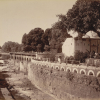S. Gopalakrishnan: What is the historical significance of Tughlaqabad?
K.K. Muhammed: When we compare Tughlaqabad with Delhi's Red Fort or Agra Fort, and others except one or two like Daulatabad or Ranthambore or Chittor Fort, it comes under the mightiest forts in India. Before Tughlaqabad, Delhi had three capitals: Lalkot, Qila Rai Pithora and Siri Fort. Lalkot was the first capital and Qila Rai Pithora was an extension of that built by Prithviraj Chauhan. Then Siri Fort was made to hold off Mongol attacks. In fact, Tughlaqabad was also built on this huge scale to ward off the Mongol attacks from the north-west frontier. Tughlaqabad had a three-tier system which many others did not have. Qila Rai Pithora and Siri Fort did not even have a double system. Tughlaqabad can only be compared with Chittorgarh—though not in terms of height—which was always considered an invincible fort. Of course, Chittor was captured by emperors like Iltutmish but during that time it was considered invincible. In my view, Tughlaqabad too should go into that category.
S.G.: Can you elaborate the three-tier system of Tughlaqabad?
K.K.M.: The three-tier system means on the lower side there is one fortification, on the middle level another fortification and then a third one. There were separate systems for guarding each fortification and for an enemy it would have been extremely difficult to break all the three tiers. When it comes to Agra Fort, that had a double fortification system—the Mughals used to keep their treasury there—but the Red Fort has only single fortification. There is a reason for it—there were no serious threats for the Mughals from outside. Therefore, they did not spend much on making huge forts.
S.G.: Please share some experiences from the conservation efforts at Tughlaqabad.
K.K.M.: It was said that the whole city was built in two years. But this is not correct. If it took five years to make Fatehpur Sikri and eight years to complete Red Fort, then I am sure that making Tughlaqabad would have taken more years. How can one complete a bigger fort in just two years? It was partly built during the five-year period of Ghiyas-ud-din Tughlaq (1320–25) and I think even during the period of Muhammad-bin-Tughlaq the work was going on. He extended it further by constructing another fort called Adilabad fort. The reason behind making another fort was probably a psychological one. He killed his father and that guilt followed him throughout. He lived sometimes in Adilabad and sometimes in Tughlaqabad and then he shifted his capital to Daulatabad. When he returned he decided not to stay in either of these forts and built another city—Jahanpanah. Jahanpanah enclosed all the three cities—Rai Pithora, Siri Fort and Tughlaqabad. Muhammad-bin-Tughlaq stayed in Bijay Mandal in Jahanpanah and the ruins of the palace still survive in Begumpuri village. But there has not been much conservation of the palace. Bijay Mandal is also known as ‘Hazaar-Sutun’ i.e., 1000-pillared palace.
The major issue regarding conservation of these forts is that most of these monuments are highly encroached upon, especially Tughlaqabad. As far as the ultimate conservation of Tughlaqabad is concerned, it is a losing battle. Another main reason is the lack of political will. The first conservation effort in the history was from Firoz Shah Tughlaq. He made efforts to conserve Qutub Minar, conserved many tombs of earlier period. Probably at that time Tughlaqabad was not in such a bad state therefore no conservation attempts were made at his end.
S.G.: Was it inhabited during Tughlaq period?
K.K.M.: It was a protected area so in some areas there were people staying. But from the beginning water shortage was a problem. Inside the fort the land is porous and it cannot retain water. Although there was a lake around, people could not stay for long periods. There was the same issue in Adilabad Fort as well. As we know, there was a huge lake around the fort and once it was emptied, both forts started facing water scarcity.
S.G.: Since when was this fort abandoned?
K.K.M.: Most probably the fort was abandoned soon after Ghiyas-ud-din Tughlaq’s death, though a few people might have stayed on in some corners of the fort. Even Adilabad was abandoned after two years. After 1336, the fort remained abandoned. During the entire Mughal period, nobody cared about this fort. Even during the British period, the fort remained unattended. Conserving Tughlaqabad fort is not an easy task as it is a huge area. Even for an organisation like ASI, its Delhi Circle is getting just Rs. 3,00,00,000 under Special Conservation efforts for preserving 174 monuments. It is peanuts. But thanks to the Commonwealth Games I could get nearly 30,00,000 for conservation and we could do some meaningful conservation in Adilabad Fort and Tughlaqabad. It is for the first time in the history of Tughlaqabad that some conservation efforts happened. During the Commonwealth Games we could do the same with Qila Rai Pithora and Siri Fort. The government should keep up this tempo.
S.G.: What about the city inside Tughlaqabad?
K.K.M.: It was not a planned city. Even in the case of the Mughals, except for Chandni Chowk there was no planned city in Delhi, in contrast to the Roman cities.
S.G.: What are the significant areas of Tughlaqabad?
K.K.M.: The Bijay Mandal, the citadel area where the king was living and the palace area. Both these places had their own baolis. Besides these two, there was a third area where the commoners used to live.
K.K. Muhammed is the former Regional Director (North) of the Archaeological Survey of India (ASI).










